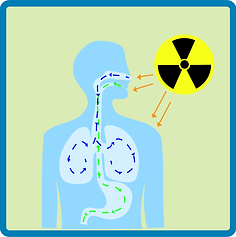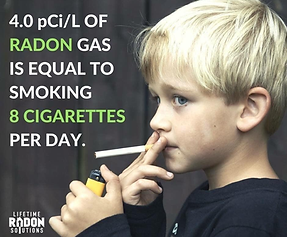FREQUENTLY ASKED QUESTIONS
WHAT IS RADON?
Radon is a colorless, odorless, tasteless, gas that is carcinogenic. It is naturally occurring and is present in low levels in the air we breathe outdoors (typically around 0.4 pCi/L). The EPA projects that indoor radon levels may be between 1.3 pCi/L and 4.0 pCi/L depending on your home.
HOW DOES RADON ENTER MY HOME?
Radon's primary entry point is through the soil. The amount of radon in the soil depends upon the soil chemistry and varies among houses and may be affected by weather, soil moisture and porosity, home construction, foundation types, and home pressure. Radon levels vary by region but are present in every State.
WHAT ARE SOME ENTRY POINTS OF RADON INTO MY HOME?
● Cracks in floors or walls of the foundation
● Gaps in suspended floors
● Openings around sump pumps and drains
● Wall cavities
● Construction joints
● Gaps around service pipes or wires
● Crawl spaces
● The water supply (Radon can affect bodies of water, specifically ground water)
WILL MY NEIGHBOR'S RADON RESULTS IMPACT THE RESULT OF MY HOME?
No. Radon levels vary from house to house. The only way to know if you have a radon problem is to conduct a test. "...Your home can have elevated levels of radon while your neighbor's home does not. Testing is the only way to determine if you have a problem. Radon testing is easy and inexpensive, and it could save your life. Thousands of lung cancer deaths could be avoided each year if homes with elevated radon underwent changes to reduce radon pollution." [3]
WHEN SHOULD A RADON TEST BE PERFORMED?
If you are buying a house, the USEPA recommends a radon test for EVERY real estate transaction. Earlier testing is advised if renovations are being performed on the building. Retesting of radon should be performed on a biennial basis.
ARE HOMES BUILT WITH RADON RESISTANT MATERIALS RADON PROOF?
The only way to identify if a dwelling has radon present is to conduct a short- or long- term radon test. All buildings will have radon present. Even homes with integrated Radon Resistant New Construction (RRNC), such as passive new construction pipes (PNPs).
When explained further, Radon Resistant New Construction (RRNC), is simply the installation of the radon system pipes without the fan. Making the home "radon system ready," but certainly not resistant to its entry.
*If buying from a builder, inquire about the reimbursement options available on new RRNC homes that require the home have a fan installed on the home's radon system to make it meet standards. Many builders offer free or discounted mitigation fan installation on new RRNC homes (if necessary).
HOW WILL I KNOW IF THERE IS LEAD BASED PAINT USED IN MY HOUSE AND IF THERE IS NEED FOR ACTION?
The older your home, the more likely it contains lead-based paint. For example, 87% of homes built before 1940 have some lead-based paint, while 24% of homes built between 1960 and 1978 have some lead-based paint.
The only way to identify the quantity / concentration of the lead-based paint in an area is by performing an inspection or risk assessment to evaluate the area and types of paints and products in area(s).
WHAT IS A HIGH RADON LEVEL?
There is no safe level of radon exposure. Radon gas is measured in picocuries per liter (pCi/L). The current airborne radon level at which the EPA and IEMA recommend action is 4.0 pCi/L.
Citations:
[1]http://www.epa.gov/schools/guidelinestools/ehguide/downloads/OCHP_Healthy%20SchoolsFactsheet.pdf
[2]"A Physician's Guide | Radon | U.S. EPA." U.S. Environmental Protection Agency. http://www.epa.gov/radon/pubs/physic.html#WhatIs (accessed December 24, 2014).
[3]"Health Risks | Radon | U.S. EPA." U.S. Environmental Protection Agency. http://www.epa.gov/radon/healthrisks.html (accessed December 24, 2014).
Credits: NIR would like to thank the ACS, EPA, InterNACHI, NACHI and UIC for photos and graphs included in the website.
What is Radon Gas?

#1 Cause of Lung Cancer (Among people who have never smoked)
#2 Leading Cause of lung cancer
among current and former smokers.

Radon:
The "Silent Killer"
Properties of Radon Gas
C - Colorless
O - Odorless
T - Tasteless
I - Inert [chemically]
N - Naturally occurring soil gas
that is carcinogenic.
It is naturally occurring and is present in low levels in the air we breathe outdoors (typically around 0.4 pCi/L). The EPA projects that indoor radon levels may be between 1.3 pCi/L and 4.0 pCi/L depending on your home.
Latency Period for radon exposure cancer.
Radon possesses properties which make its carcinogenic properties unnoticeable for many years.
The latency period for lung cancer caused by radon exposure has been approximated to be 5 to 25 years after initial exposure. (epa.gov)

Children are most vulnerable to radon exposure.
Children are more vulnerable to the harmful effects of radon gas because their lungs are still developing and they breathe faster than adults, which means they can inhale more radon over the same period. Additionally, children typically spend more time indoors—where radon concentrations are higher—especially in lower levels of homes like basements where radon tends to accumulate. Over time, this increased exposure can raise their risk of developing lung problems, including cancer, later in life.
Is there a safe level of radon gas?

